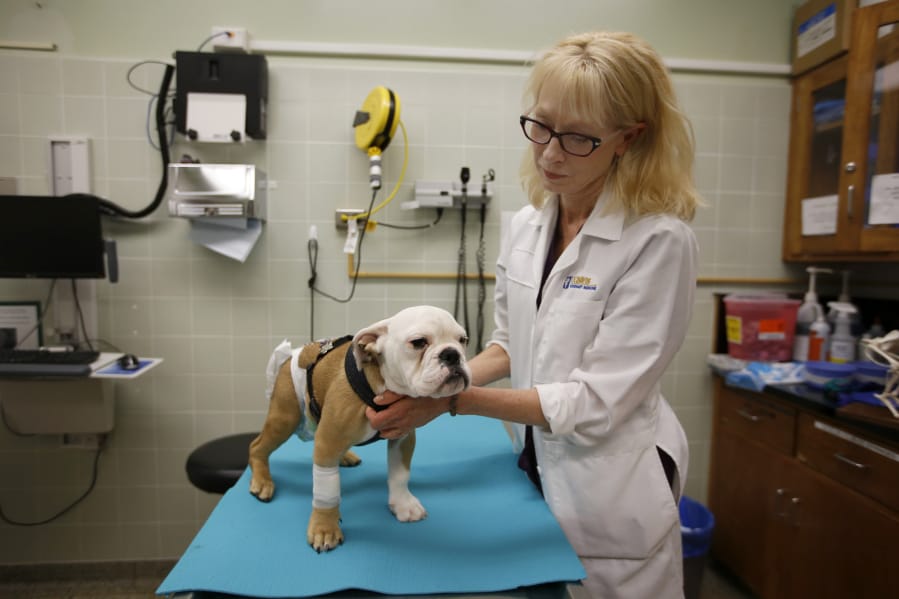DAVIS, Calif. — Patients from around the world come to the University of California, Davis Veterinary Medical Teaching Hospital, a showcase of pioneering therapies. The top-ranked veterinary program in the world offers 34 specialties including cardiology, oncology and neurology.
Among the patients were bulldogs with spina bifida who came for stem cell therapy, a lame horse who was diagnosed using a scanner found in no other animal hospital, and a dog who became a hero in the Philippines when she threw herself between a speeding motorcycle and two children.
More than 50,000 animals a year — as small as a hamster, as big as buffalo — are cared for by the hospital’s 120 faculty veterinarians and nearly 600 interns, residents, fellows, technicians and students.
Its specialists assist endangered gorillas in Africa, penguins in Brazil — even residents, including tarantulas and giraffes, of the nearby Sacramento Zoo.
The hospital recently launched a $508 million project to double its size in 10 years, which would make it one of the world’s largest veterinary hospitals.
“It’s a real gift to have a world-famous vet hospital an hour away,” said Mary Shallenberger of Clements, who brought in her 4-year-old quarter horse, Oscar, for a spinal tap after she noticed weakness in his hindquarters. He has since made a complete recovery.
Here’s a look at some of the animals in need and the doctors who cared for them.
Spanky and Darla
Spanky and Darla bounded into the exam room, all floppy-eared and wrinkly-faced. The English bulldogs seemed perfectly normal — except for their diapers, held up by animal-print suspenders. Brother and sister, they were born with spina bifida, and their improperly formed spinal columns made them incontinent and not so steady on their feet. The dogs’ owner planned to euthanize them. Val Vallejo, a Los Angeles County sheriff’s deputy who runs the nonprofit Southern California Bulldog Rescue, brought them to UC Davis instead.
At UC Davis, Darla and Spanky became medical pioneers when the medical and veterinary schools teamed up in February to provide them with the first-ever spina bifida treatment for dogs that combined surgery and stem cells.
A team led by Dr. Beverly K. Sturges, a veterinary neurosurgery professor, repositioned misplaced tissue around the dogs’ spinal columns. Then placental stem cells developed by Drs. Aijun Wang and Dori Borjesson, professors and stem cell researchers, were applied to cover the gaps in the spinal columns and promote regeneration.
The dogs still need their diapers. It’s unclear whether that issue will ever be cleared up.
But, said Vallejo, who drove all night for the recent check-up, “Their gait looks better.”
And so do their prospects. Darla and Spanky, Vallejo reported, are happy and living with a permanent family in New Mexico.
Danika
Danika arrived four weeks prematurely, a Friesian foal the color of coffee, with a white star on her forehead. She was born so early that her bones had not fully formed. So at UC Davis, LuzMaria Soto, studying animal science, sat next to the horse to keep her from trying to stand up on her own. If she had, she might have damaged her bones and become permanently lame.
Danika was in good hands at the hospital’s Neonatal Intensive Care Unit. The team there is used to treating serious problems, including ruptured bladders and sepsis, said Dr. Gary Magdesian, a professor of equine critical care.
Soto and other volunteers with the UC Davis Foal Team stay with preemies around the clock.
The unit features adjoining stalls, so Danika’s mom, Rixt, was able to stay close, peeking over the divider with a watchful eye.
Every two hours, the volunteers let Danika up for assisted standing. Every four hours, they helped her bear weight by straddling an exercise ball. The foal also was given enzymes to treat a gut problem. After five weeks in the NICU, Danika was declared good to go.
Scooby
Scooby is 15 years old. He’s a chestnut-colored German warmblood horse. His specialty is dressage. He’s an expert in show riding. But when he began limping in March, no one at first knew where the trouble was.
In April, UC Davis veterinarians hoisted all 1,300 pounds of him onto an examining table and placed tubes for oxygen and anesthesia gas in his mouth. His right hind leg poked though a wide circular tube in a positron emission tomography, or PET, scanner. UC Davis was the first veterinary medical hospital anywhere to use such a machine on horses.
By injecting the leg with a weak dose of a radioactive substance that attaches to areas of abnormal bone, the veterinarians were able to see detailed images of Scooby’s injury.
“This can detect lesions missed by MRI and CT scans, which could prevent catastrophic breakdowns in racehorses,” said Dr. Mathieu Spriet, an associate professor of surgical and radiological sciences. And the low-level radiation doesn’t hurt the horse.
Scooby’s scans found a small crack that led to inflammation nearby. After months of medication and rest, Spriet said, he is back to being ridden at a walk and trot pace and appears to be on the right track.



